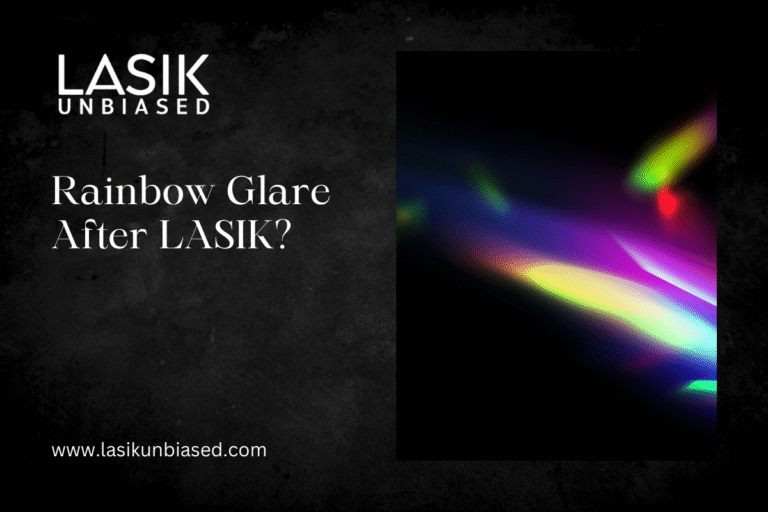Experiencing rainbow glare after LASIK is an uncommon but recognised phenomenon in some patients, often caused by light diffraction at the corneal flap created during the procedure.
While it is usually temporary, understanding its occurrence, implications, and remedies can put your mind at ease.
LASIK (Laser-Assisted in Situ Keratomileusis) is one of the most widely trusted and popular vision correction surgeries available today. Yet, like any medical procedure, it can lead to minor side effects. One lesser-known but intriguing effect observed by some patients is the appearance of “rainbow glare” or prismatic halos around light sources. This blog dives deep into what causes this phenomenon, how it manifests, and what you can do about it.
What Causes Rainbow Glare After LASIK?
The Role of the Corneal Flap
The LASIK procedure involves creating a thin flap on the cornea, which is then lifted to allow the excimer laser to reshape the underlying tissue. This corneal flap can act as a secondary refractive surface, causing light dispersion. In particular, when created by femtosecond lasers, microscopic grid-like patterns on the flap interface may cause diffraction of light. This diffraction often results in subtle rainbow-like patterns around lights, especially in dimly lit conditions.
Diffraction and the Excimer Laser
The excimer laser plays a critical role in reshaping the cornea by ablating the underlying stromal tissue after the flap is lifted. It does not interact directly with the flap surface and, therefore, typically does not cause the micro-patterns responsible for rainbow glare. Instead, diffraction and rainbow glare usually result from microscopic irregularities at the flap interface caused during flap creation.
Optical Healing Process
During the healing process, microscopic imperfections on the corneal flap interface can exaggerate the light-scattering effect. This is why many patients report rainbow glare during the first few weeks post-surgery. For most patients, rainbow glare resolves within weeks to a few months, but in rare cases, it may persist longer, sometimes requiring further evaluation.
Characteristics and Symptoms of Rainbow Glare
When and Where You’ll See It?
Patients most often notice rainbow glare in low-light or dark environments, particularly when looking directly at bright light sources such as street lamps, car headlights, or smartphone screens. These lights stand out visually, making any glare or prismatic halos more noticeable.
Is It Painful or Harmful?
While rainbow glare is not painful, it can be distracting, especially for individuals who drive at night or work under artificial lighting. It typically does not indicate any damage to the eye or LASIK failure; rather, it is a visual side effect related to the optical changes occurring during the healing process.
Temporary vs Long-Term Effects
For most patients, rainbow glare subsides within a few weeks as the corneal flap fully adheres and the eyes adjust. It rarely persists beyond the typical recovery period. In uncommon chronic cases, persistent symptoms may be related to individual healing variations or specific surgical factors such as flap thickness or corneal shape.
Factors That May Influence Rainbow Glare
Laser Technology Used
Modern femtosecond lasers used for flap creation offer greater precision but can sometimes produce microscopic grid patterns on the flap interface, potentially leading to rainbow glare. Older mechanical microkeratomes rarely cause this diffraction pattern but carry other flap-related risks.
Pupil Size
Individuals with larger pupils may observe more pronounced rainbow glare. This is because light enters through a wider area of the cornea, amplifying diffraction effects at night or in dim settings.
Individual Healing Variability
Healing rates vary from person to person, and the speed at which the corneal flap adheres can affect visual symptoms. Patients with slower flap healing may experience a longer duration of rainbow glare.
Strategies to Manage Rainbow Glare
Allowing Proper Healing Time
Patience is key. The majority of rainbow glare cases resolve naturally within a few weeks to a few months post-surgery. Avoid overly stressing your eyes during this critical healing window by resting regularly and limiting exposure to bright screens.
Use of Eye Drops
Post-surgical dryness can exacerbate visual anomalies, including rainbow glare. Keeping your eyes moist with prescribed lubricating eye drops can reduce overall discomfort and improve clarity.
Specialised Glasses for Light Sensitivity
For those who experience significant discomfort, anti-glare or blue-light blocking glasses can provide temporary relief. These glasses help minimise light diffusion and can make night-time driving or computer work more manageable.
Report Persistent Symptoms to Your Surgeon
If rainbow glare persists beyond the typical recovery timeline or worsens, reach out to your eye surgeon. If persistent and bothersome, treatment options may include specialised contact lenses or, in rare cases, flap relifting and smoothing; however, such interventions are uncommon.
Can Rainbow Glare Be Prevented?
Pre-Surgical Evaluations
Consulting a skilled ophthalmologist is critical to assess your candidacy for LASIK and pinpoint any potential risk factors for rainbow glare. Surgeons will evaluate corneal thickness, pupil size, and other metrics to ensure optimal outcomes.
Precision Laser Technology
Choosing clinics equipped with advanced laser systems, including the latest femtosecond and excimer lasers, can help minimise the risk of side effects such as rainbow glare. Modern laser technology is designed to reduce micro-pattern irregularities and improve precision, promoting a smoother healing experience.
Post-Surgical Care
Following your doctor’s post-operative care instructions can significantly impact your healing process. Avoid rubbing your eyes, adhere strictly to eye drop schedules, and attend all follow-up appointments to monitor your progress.
Dispelling Common Myths About Rainbow Glare
Myth 1: It Happens to Everyone Post-LASIK
Not all LASIK patients experience rainbow glare. Its occurrence depends on individual factors and circumstances during surgery.
Myth 2: It Indicates LASIK Failure
Rainbow glare is not a sign of surgical failure. It is a temporary and manageable side effect observed in certain cases. Most individuals go on to achieve excellent visual outcomes without lasting issues.
Myth 3: It Cannot Be Treated
For cases where symptoms persist, advanced treatments and adjustments are available to improve visual quality. Always consult with your surgeon for tailored advice.
When Should You Be Concerned About Rainbow Glare?
While most cases resolve on their own, seek medical advice if you experience:
- Persistent glare lasting over six months
- Intense discomfort that interferes with daily life
- A sudden increase in severity
These could indicate underlying complications requiring medical attention. Being proactive ensures the best possible recovery experience.
Gaining Clarity After LASIK
Rainbow glare after LASIK is often a temporary side effect that occurs as your eyes heal and adjust post-surgery. With the advancements in laser technology and proper aftercare, most individuals will see this phenomenon fade over time.
If you’re considering LASIK or have recently undergone the procedure, discuss any concerns about rainbow glare with your surgeon. Most importantly, trust the process and give your eyes the comfort and care they need to heal successfully.


